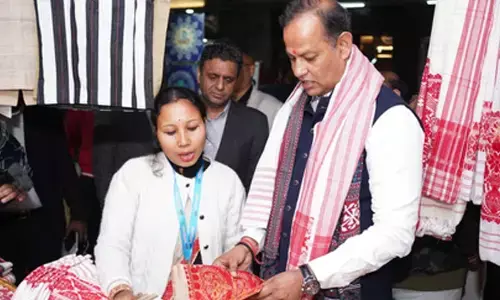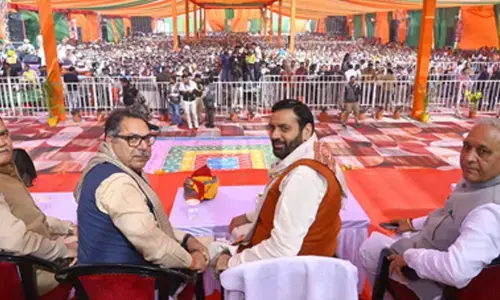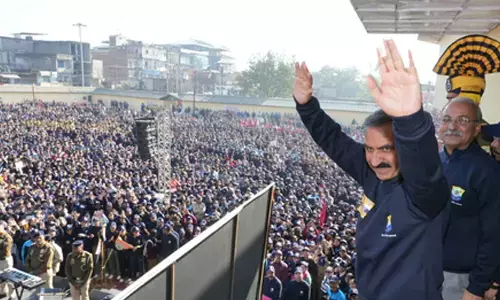Devdutt Pattanaik decodes the words ‘tirtha’ and ‘marga’ - and much else - in riveting talk

Mythologist and best-selling author Devdutt Pattanaik explored the uncharted terrain of infrastructure in mythology in a talk that covered an incredible range, from the rationale of the location of the shrines of Kedarnath and Badrinath to the fact that the Harappan Civilisation was a mercantile society where armies were conspicuous by their absence.
Mythologist and best-selling author Devdutt Pattanaik explored the uncharted terrain of infrastructure in mythology in a talk that covered an incredible range, from the rationale of the location of the shrines of Kedarnath and Badrinath to the fact that the Harappan Civilisation was a mercantile society where armies were conspicuous by their absence.
Delivering the inaugural talk in the monthly Infra Katha series at the India Habitat Centre, Pattanaik, whose latest book is titled ‘Sati Savitri: And Other Feminist Stories They Don’t Tell You’ (Penguin Random House), noted that the remote location of Kedar-Badri may seem inexplicable today, but the shrines, a long time ago, were strategically located on the trade route to Tibet.
As a result of the regular flow of people to and from Tibet, the shrines were both places of worship and shelter for weary traders. And why was Tibet so important once upon a time?
To highlight the importance of Tibet, which is now under Chinese occupation, Pattanaik reminded the audience of the Hindi expression ‘sone pe suhaga’ -- ‘suhaga’ is a reference to borax, which is rubbed on gold (‘sona’) to enhance its lustre. Tibet was India’s source of borax and it was a prized commodity once upon a time because without it, gold ornaments wouldn’t shine as brightly as they did.
Pattanaik pointed out that all important temples and Buddhist monasteries were located on trade routes and important highways in the past, and they used to be patronised by merchants.
Khajuraho’s famous temples, of which 22 survive till this date, for instance, were built along an arterial highway between the late ninth and early twelfth centuries. But with the rise of the Delhi Sultanate and fall of the local rulers who supported this ecosystem, the highway went into disuse and the temples were abandoned, which explains why Khajuraho today seems to be in the middle of nowhere, and the wrong place to build temples.
Having established the importance of ancient highways and trade routes, Pattanaik talked about how ancient seers would follow in the footsteps of deer (‘pugdandi’) to cross forests and walk across the shallow parts of rivers (fords, or ‘tirtha’) on their way to pilgrim centres. So, it was the mode of journey that gave birth to the Sanskrit words ‘marga’ and ‘tirtha’ to describe ‘schools of spiritual thought’ and ‘pilgrimage’, respectively.
Another riveting detail shared by Pattanaik was the fact that the Harappan Civilisation, which spread across a million square kilometres and lasted for around 700 years, has left behind not a single trace, in the numerous seals that have been discovered at its sites, of having an army or being engaged in wars.
Not a sword has been excavated anywhere in the vast sprawl of Harappan sites. Even the historic cities we associate with the civilisation were not built for protection against enemies at the time of war, but for what we would now call ‘ease of business’.
“The Harappan Civilisation was created by traders, not raiders,” Pattanaik pointed out, adding that therefore it was led by a mercantile mindset, which percolated into Hindu rituals.
At every ‘yajna’, till this date, the Sanskrit words ‘swaha’ (a request to the gods in heaven to accept the offering) and ‘tathastu’ (so be it -- an expression of acceptance) mirrors the old trader economy’s ‘give and take’ mindset, as opposed to the ‘give, or else...’ worldview of raiders.
It was this ‘mercantile mindset’ that was at play when Harappan traders carried lapis lazuli from present-day Afghanistan to Egypt, where the precious blue stone was used to adorn the gods, and brought back bitumen with which they plastered their massive public baths.
Pattanayak, who also wears the hat of a corporate coach and is the author of ‘Business Sutra: A Very Indian Approach to Management’ (Aleph Book Company), was in conversation with Vinayak Chatterjee, Chairman, National Council on Infrastructure, CII, and founder and managing trustee of the Infra Vision Foundation, the presenters of the series.
















